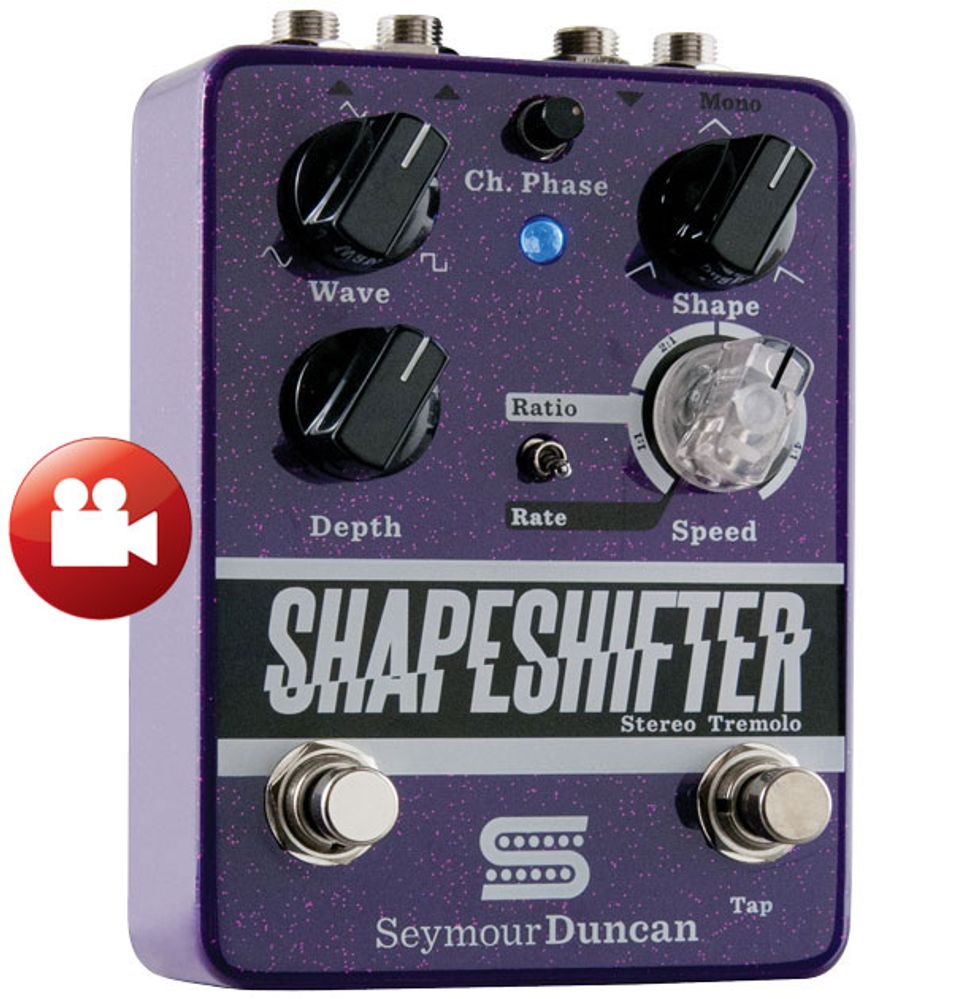
With versatile wave-shaping and rate-control options, Seymour Duncan’s original Shape Shifter was a tremolo control freak’s best pal. The new version retains the same functionality and controls as the original, but adds a stereo feature and a cool channel phase knob that modifies the synchronization between the two outputs in awesome ways. These additions make the new, more compact Shape Shifter a super-stuffed bag of tremolo tricks.
Channeling Waves
You can select three basic wave shapes—sine, triangle, and square—via the wave knob. But you can also blend wave shapes to add a slightly irregular warble to the tremolo pulses. You can further alter the wave with the shape knob, which creates uniform wave shapes or asymmetric wave shapes with a longer rise than taper—or vice versa.
There are several ways to adjust tremolo rate: Via the speed knob (when the rate toggle is engaged) or by tapping out a tempo, which can further be modified with the ratio controls. In the ratio, setting you can create subdivisions (1:1, 2:1, 3:1 and 4:1) of whatever tempo you tap in. It’s a cool way to dial in fast, but very precise tremolo pulses.
The stereo outputs add another layer of swirl, especially depending on how you adjust the new channel phase knob. At a fully counterclockwise setting, a two-amp, stereo output setup will be entirely in phase. As you turn clockwise, the output will gradually slip out of phase—all the way to a 180-degree shift, which induces sea-sick or stroboscopic effects depending on how you set the wave shape.
Ratings
Pros:
Huge range of tremolo tones and shape-sculpting options. Stereo setup is gorgeous when phase shifting the channels. Tap tempo keeps it all on the rails.
Cons:
A tad expensive.
Tones:
Ease of Use:
Build/Design:
Value:
Street:
$229
Seymour Duncan Shape Shifter
seymourduncan.com
Split Personality
My test stereo rig consisted of a Fender Twin Reverb and a Hiwatt Custom 50. Setting the wave shape between sine and triangle comes very close to imitating the optical tremolo found in the Twin Reverb, and dialing the depth to around 2 o’clock yields a taste of Johnny Marr-inspired “How Soon Is Now?” choppiness. This setting is especially effective in stereo with a strongly out-of-phase position. At a full 180-degree setting the three-dimensional effect can be intense.
With a square wave selected and the channels in phase, stereo amps produce a sputtering, if huge, on/off effect. By turning the phase to 12 o’clock, the amps slip out of sync just enough that you can start to hear the nuances of chord melodies—even at extreme depth settings. Asymmetric wave shapes can add a cool analog irregularity, especially at high-depth settings. These extreme settings aren’t always the most musical, but they highlight the Shape Shifter’s ability to create effective, deep, and disorienting sci-fi textures.
To get more traditional tremolo sounds, simply dial up a triangle wave and roll back the depth. Ditching the stereo setup negates the phase control, but even in single-amp applications, the Shape Shifter sounds deep and rich, and depending on where you set the shape knob, the pedal delivers a cool trace of pitch shift. The harmonic richness of a Les Paul’s humbuckers are especially effective for highlighting this dimensionality, which you can tastefully enhance with stronger depth settings.
The Verdict
There are cheaper tremolo pedals out there, but few trems chop in as many shades as this chameleon. The Shape Shifter can generate everything from Fender- to Vox-style trem textures, which will make it appealing to those whose amps lack a tremolo circuit. And if you’re seeking more bizarre and unexpected colors, the Shape Shifter offers a ton of them too.
Watch the Review Demo:







![Rig Rundown: Russian Circles’ Mike Sullivan [2025]](https://www.premierguitar.com/media-library/youtube.jpg?id=62303631&width=1245&height=700&quality=70&coordinates=0%2C0%2C0%2C0)

















